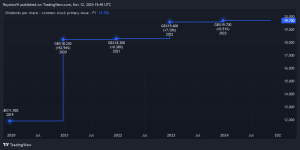Lloyds (LSE: LLOY) shares have done really well since I first started buying them at 42p last year. In fact, they’re currently at a 52-week high of 59p, representing a 40% gain on my initial purchase. I also invested at 50p.
However, while I think the FTSE 100 bank stock could yet run higher with the improving UK economic outlook, I’ve decided to sell up. And I plan to recycle some gains into HSBC (LSE: HSBA). Here’s why.
Higher yield
The first reason is that HSBC carries a higher dividend yield than Lloyds right now. The former is 7.3% compared to the Black Horse Bank’s 4.7%. That means I can hope to bag higher passive income by investing more money in HSBC today.
Of course, this assumes some financial crisis doesn’t bubble up and force lenders to start cutting dividends, which has happened in the past and could again. That’s why I don’t want too much FTSE 100 banking exposure.
Looking at the forecast yields, they both appear attractive, though HSBC appeals to me more.
| FY24 | FY25 | FY26 | |
| HSBC | 9.2%* | 7.2% | 7.3% |
| Lloyds | 5.5% | 5.9% | 6.6% |
Domestic versus global
I also prefer HSBC’s higher long-term growth potential. It’s a global bank with ambitions to spread its tentacles further across Asia, the world’s fastest-growing region.
However, this does mean it has sizeable exposure to mainland China, which is a bit of a wildcard right now due to its struggling economy and property crisis. Last year, HSBC’s earnings were hit by a massive $3bn write-down on its stake in one of China’s largest lenders (Bank of Communications).
More broadly, tensions between the US and China could escalate further, especially if Donald Trump is elected. And that could cause a bit of volatility.
In contrast, Lloyds is focused almost entirely on the domestic UK economy. It’s therefore more sleepy and arguably a bit less risky. If I were nearing retirement, I’d probably favour the UK’s biggest mortgage lender over HSBC. But I’m not.
Rate headwinds for banks
Last year, HSBC reported a record pre-tax profit of $30.3bn. That was a 78% rise on the year before.
However, much of that surge in profits was down to higher interest rates, a tailwind that is expected to fade as major central banks make multiple rate cuts this year. On the flip side, the risk of loan defaults should diminish.
For the second quarter, HSBC is expected to report revenue of $16.1bn, down about 5% from last year. Profits are also expected to decline, indicating that earnings may have peaked.
That said, I’m reassured that the dividend still appears well-supported. Plus, the stock is cheap, trading on a forward price-to-earnings (P/E) ratio of just 6.9, while the bank announced a new $3bn share buyback programme in April.
I’m buying more shares
Since 2021, the firm has acquired asset-management operations in India and Singapore, as well as mainland China. These markets offer exciting economic growth stories and strong earnings potential.
On balance, I feel the stock is worth buying for my portfolio in anticipation of potentially much higher profits down the road. And I reckon there’s a better chance of HSBC achieving higher share price gains than Lloyds.
This post was originally published on Motley Fool





